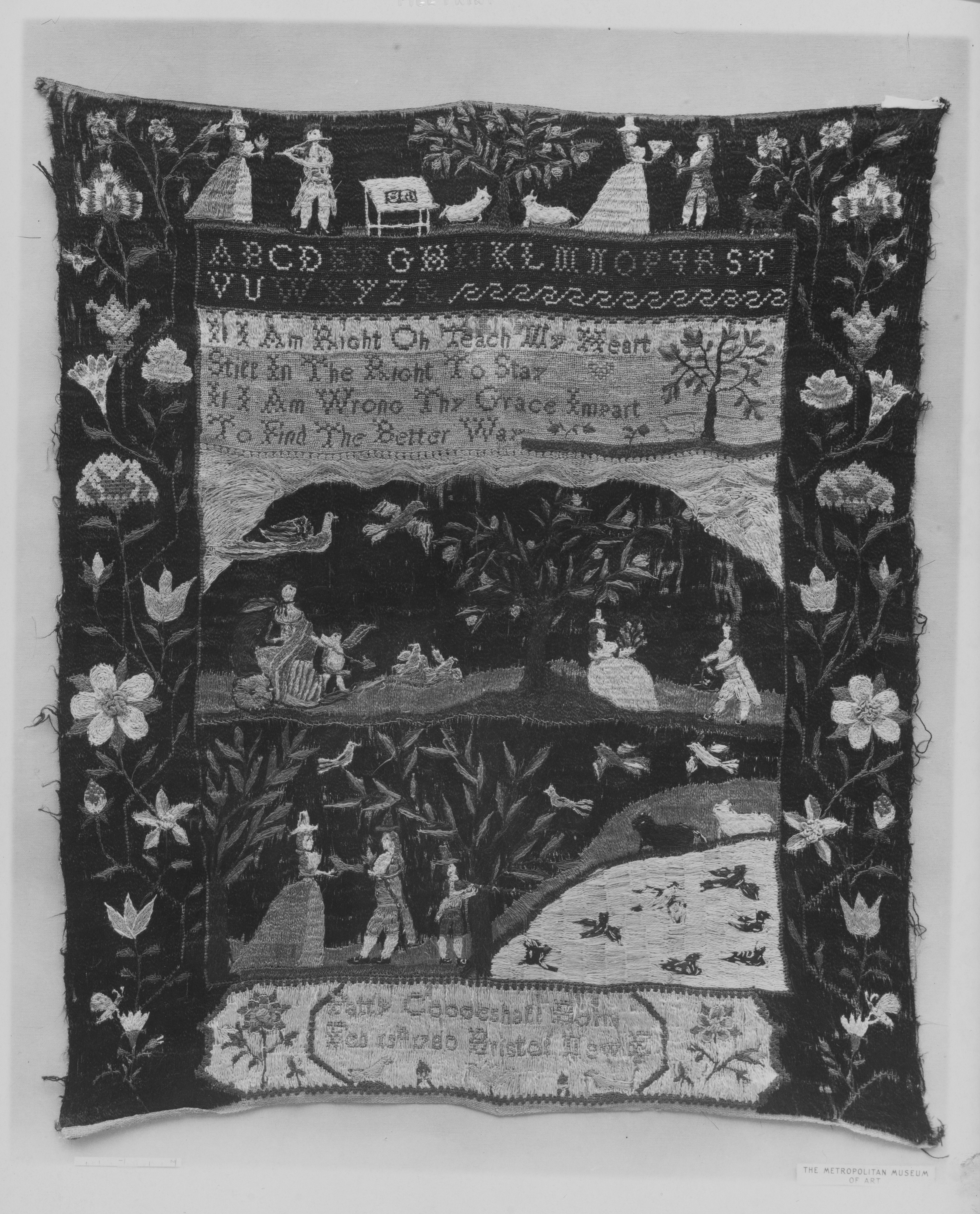Sampler
Martha (Patty) Coggeshall American
Patty Coggeshall’s elaborate, densely filled sampler is thought to have been made at the Bristol, Rhode Island school run by Anne Bowman Usher (1723-1793). This highly respected boarding and day school was active from about 1774 to 1793, attracting students from prosperous Bristol and Providence families. The Met has two of the four samplers attributed to the Usher school--Patty’s dating to ca. 1792 and Peggy Ingraham’s dating to 1790. (MMA 1984.331.12). Characteristic of Usher School samplers, both display the dramatic use of black stitched silk backgrounds; the anomaly in the alphabet of the "V" preceding the "U;" and a vocabulary of distinctive motifs in a central area surrounded by a meandering floral three-sided border. In a cartouche at the bottom both girls stitched their name, birth date, and "Bristol" in black silk.
Patty’s sampler is the most fully realized of the Bristol samplers and her motifs include four animated courting couples as well as Venus and Cupid, and a huntsman. She used a profusion of colorful silk twist, floss, and metal wrapped thread in a variety of stitches to enhance her designs. Rococo stitch, seed stitch, and long-and-short stitches combine to augment the foliage, costumes, and the long-tailed bird flying above Venus.
For the young women born following the American Revolution, marriage was the central defining experience of their lives and the romantic notions expressed in the poetry, music, and literature popular in Federal-era America are seen in Usher school samplers. Patty’s four animated couples are exchanging love tokens, including one gentleman playing a flute, reading sheet music on a stand. Venus, goddess of love, sits in her chariot pulled by two doves and Cupid stands beside her ready to cast his arrow. The exuberance and optimism of the sampler reflects the flourishing prosperity of Bristol at the time when the city was becoming a major hub of New England’s transatlantic triangle trade.
Between 1789 and 1793, one-third of Rhode Island’s merchant ships sailed from Bristol. The retail stores that lined the main streets, and the commercial waterfront warehouses were filled with goods coming from England, Europe, China, India, South America and the Caribbean. The Bristol economy was driven by the slave trade, involving local merchants, bankers, financiers, boat builders, ship captains and sailors, tradesmen and craftsmen, as well as rum distillers. It was common for well-to-do Rhode Island families to have enslaved servants. Patty grew up in a household with an enslaved woman named Menea and Anne Usher’s husband, Hezekiah Usher, owned an enslaved man named York, who lived in the house shared with students. Amongst the Usher School’s rules of behavior that were handed out to the students was the dictum: "You are to speak to the servant with mildness & if you have a request to make let it be with—will you be so kind as to do this or that."
Patty Coggeshall was the daughter of William Coggeshall (1719-1796) and his second wife, Margaret Munroe (1744-1809). Although both the Coggeshall and Munroe families were among of the earliest English settlers in Rhode Island, Patty’s father’s occupation remains unknown. Her father died in 1796, followed a year later by Patty’s own death at age seventeen. The preservation of Patty’s sampler by generations of her family is a tribute to the importance needlework held as a document of her education and as a symbol of the family’s status within the community.
Due to rights restrictions, this image cannot be enlarged, viewed at full screen, or downloaded.
This artwork is meant to be viewed from right to left. Scroll left to view more.



